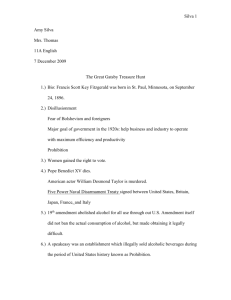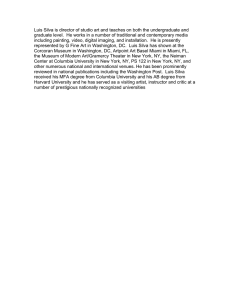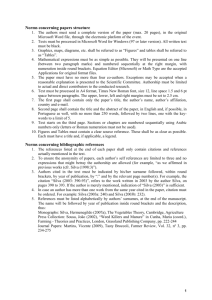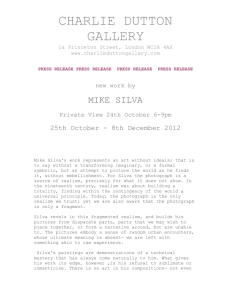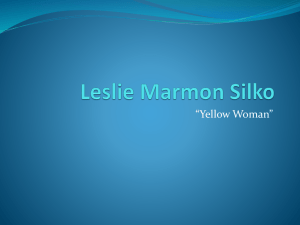the four reports and answer questions 1 – 3.
advertisement
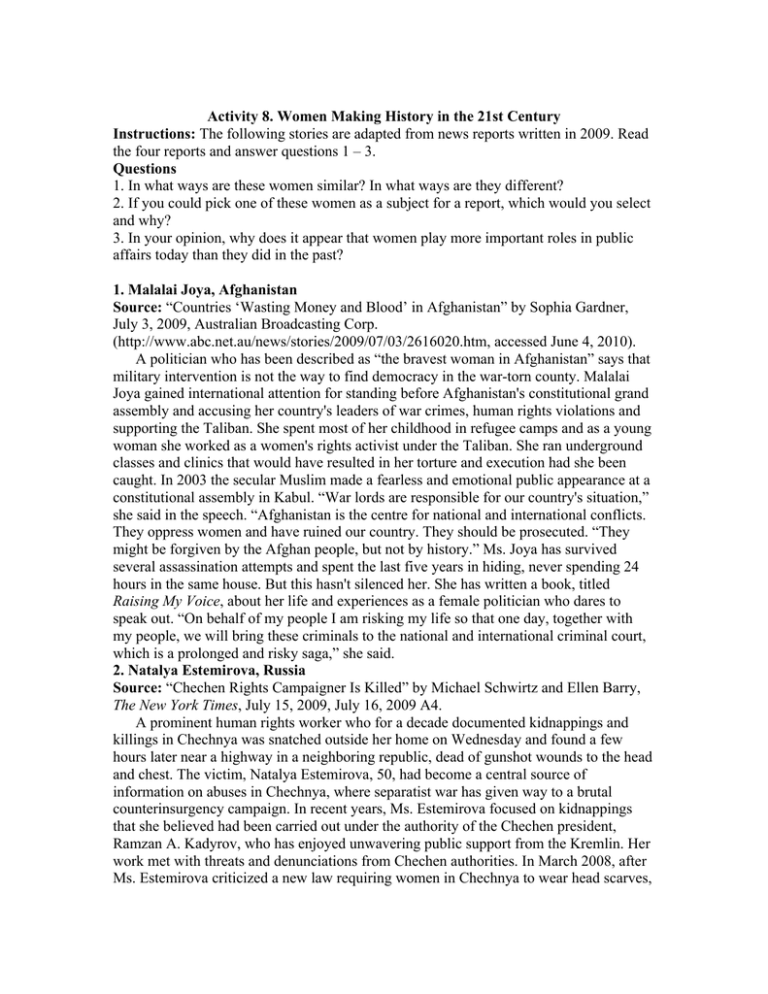
Activity 8. Women Making History in the 21st Century Instructions: The following stories are adapted from news reports written in 2009. Read the four reports and answer questions 1 – 3. Questions 1. In what ways are these women similar? In what ways are they different? 2. If you could pick one of these women as a subject for a report, which would you select and why? 3. In your opinion, why does it appear that women play more important roles in public affairs today than they did in the past? 1. Malalai Joya, Afghanistan Source: “Countries ‘Wasting Money and Blood’ in Afghanistan” by Sophia Gardner, July 3, 2009, Australian Broadcasting Corp. (http://www.abc.net.au/news/stories/2009/07/03/2616020.htm, accessed June 4, 2010). A politician who has been described as “the bravest woman in Afghanistan” says that military intervention is not the way to find democracy in the war-torn county. Malalai Joya gained international attention for standing before Afghanistan's constitutional grand assembly and accusing her country's leaders of war crimes, human rights violations and supporting the Taliban. She spent most of her childhood in refugee camps and as a young woman she worked as a women's rights activist under the Taliban. She ran underground classes and clinics that would have resulted in her torture and execution had she been caught. In 2003 the secular Muslim made a fearless and emotional public appearance at a constitutional assembly in Kabul. “War lords are responsible for our country's situation,” she said in the speech. “Afghanistan is the centre for national and international conflicts. They oppress women and have ruined our country. They should be prosecuted. “They might be forgiven by the Afghan people, but not by history.” Ms. Joya has survived several assassination attempts and spent the last five years in hiding, never spending 24 hours in the same house. But this hasn't silenced her. She has written a book, titled Raising My Voice, about her life and experiences as a female politician who dares to speak out. “On behalf of my people I am risking my life so that one day, together with my people, we will bring these criminals to the national and international criminal court, which is a prolonged and risky saga,” she said. 2. Natalya Estemirova, Russia Source: “Chechen Rights Campaigner Is Killed” by Michael Schwirtz and Ellen Barry, The New York Times, July 15, 2009, July 16, 2009 A4. A prominent human rights worker who for a decade documented kidnappings and killings in Chechnya was snatched outside her home on Wednesday and found a few hours later near a highway in a neighboring republic, dead of gunshot wounds to the head and chest. The victim, Natalya Estemirova, 50, had become a central source of information on abuses in Chechnya, where separatist war has given way to a brutal counterinsurgency campaign. In recent years, Ms. Estemirova focused on kidnappings that she believed had been carried out under the authority of the Chechen president, Ramzan A. Kadyrov, who has enjoyed unwavering public support from the Kremlin. Her work met with threats and denunciations from Chechen authorities. In March 2008, after Ms. Estemirova criticized a new law requiring women in Chechnya to wear head scarves, Mr. Kadyrov summoned her to a personal meeting and threatened her, an experience so frightening that she went abroad for several months, said Tatyana Kasatkina, deputy director of the Russian human rights group Memorial, where Ms. Estemirova had worked since 1999. Friends tried to convince Ms. Estemirova to stay away, but she felt compelled to return. 3. Rebiya Kadeer, China Source: “Uighur Leader Raises New Accusations” by Andrew Jacobs and Martin Fackler, The New York Times, July 30, 2009, A12 In the weeks since ethnic bloodletting claimed nearly 200 lives in the northwest Chinese region of Xinjiang, the government has been waging a global propaganda war against Rebiya Kadeer, the exiled Uighur leader it accuses of instigating the violence. As a result, Ms. Kadeer, who spent more than four years in a Chinese prison and now lives in the United States, has emerged as the international face of the Uighur cause. On Wednesday, she ratcheted up the war of words during a visit to Japan, where she claimed that “nearly 10,000” Uighurs had disappeared “overnight” in Urumqi, the Xinjiang capital. “Where did they go?” she asked during a news conference, according to The Associated Press. “Were they all killed or sent somewhere? The Chinese government should disclose what happened to them.” The true story of what happened in Urumqi may never be known. But Ms. Kadeer’s and the Chinese government’s dueling, sometimes hyperbolic, accounts have sowed confusion and created an even wider chasm between the government and those pressing for greater Uighur autonomy. 4. Marina Silva, Brazil Source: “A Child of the Amazon Shakes Up a Nation’s Politics” by Alexei Barrionnievo, The New York Times, August 29, 2009, A6 For Marina Silva, life began in the heart of the Amazon. Born in Seingal Bagaço, a small community of rubber tappers. Ms. Silva was one of eleven children, three of whom died. At eleven, she began working with her father as a rubber tapper. After Ms. Silva became ill with hepatitis she enrolled in a course for illiterate adults, worked as a maid, and soon finished primary school. She entered college, graduating at 26 with a history degree. During that period she met Chico Mendes, a rubber tapper who organized workers to warn about the dangers of burning and clearing the forest and about the displacement of traditional Amazon communities. Ms. Silva joined Mr. Mendes’s movement, which involved peaceful demonstrations, and it led her into politics. When Luiz Inácio Lula da Silva was elected Brazil’s president in 2002, he picked Ms. Silva to be his environmental minister. Last week Ms. Silva shook up Brazilian politics by announcing she was leaving Mr. da Silva’s Workers’ Party to join the Green Party, where she is likely to be its candidate in next year’s presidential election.
